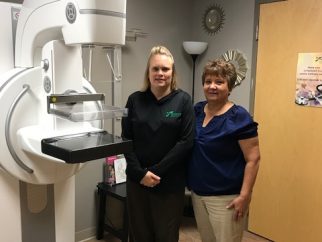In 2017, about 9,700 mammograms were performed throughout Trinity Health.
In August 2017, Cary Hutchins of Williston went in for her mammogram — her first, in fact — at Trinity Community Clinic-Western Dakota. Since she did not have a history of breast cancer in her family, Hutchins, then 56, figured that a mammogram “wasn’t something I was going to do.”
However, when Heather Riely, BSRT(R)(M), RDMS, the radiology supervisor at Western Dakota, approached her about getting one done, “we scheduled something,” Hutchins said. “And as it turns out, they actually found something.”
According to the National Breast Cancer Coalition, more than 75 percent of women with breast cancer have no family history of the disease. However, family history is still a risk factor. A family history would include having two or more first-degree relatives — a mother, sister or daughter — or second-degree relatives — an aunt, niece, or grandmother — who have had breast cancer.
When the results from Hutchins’s mammogram came back, it was determined that a biopsy was needed. The report for the biopsy indicated invasive ductal carcinoma. Invasive ductal carcinoma (IDC) is the most common form of breast cancer; about 8 of every 10 invasive breast cancers are invasive ductal carcinomas, the American Cancer Society said. IDC starts in the cells that line a milk duct in the breast, breaks through the wall of the duct, and grows into the nearby breast tissues. “At this point, it may be able to spread — or metastasize — to other parts of the body through the lymph system and bloodstream,” the ACS said on their website.
Thankfully, in Hutchins’s case, it was caught soon enough. The carcinoma included “two little modules. They were so small, I would have never felt it myself,” she said. Thankfully, the 3D mammography technology could detect them. “They were really tiny.”
Hutchins had more tests done to pinpoint where exactly the ICD was, consulting with Madhu Unnikrishnan, MD, an oncology with Trinity CancerCare Center. Before long, on October 25, 2017, she was in surgery, where she had a lumpectomy; a lymph node was also removed “just to make sure it hadn’t gone any further.”
Since then, her follow-up appointments have gone well, with scans showing no signs of cancer.
“Trinity was absolutely wonderful,” Hutchins added. “My care from beginning to end included a good support team and great nurses.”
According to the Centers for Disease Control and Prevention, the number of new cases of breast cancer have increased slightly over the years. The ACS estimates that about 266,120 new cases of invasive breast cancer would be diagnosed in women this year. Additionally, about 63,960 new cases of carcinoma in situ (CIS), a non-invasive and earliest form of breast cancer, would be diagnosed, and about 40,920 women would die from breast cancer in 2018.
Men make up less than one percent of breast cancer cases. Men have less breast tissue than women, which would logically lower the risk of men developing breast cancer. However, the risk is still there and many men ignore the symptoms — lumps, inverted nipples, nipple discharge, and open sores (specifically on the nipple) — shrugging it off as a disease that only women could get.
Mammograms are important because they can help detect cancer early when it is most treatable.
Since 2015, the Wide-Angle True Breast Tomosynthesis, the most up-to-date 3D breast imaging system on the market, has been available for patients at Trinity Health. At Western Dakota, the recent addition of technologists to help facilitate smooth scheduling has helped patients get timely mammograms.
“Everybody’s loving that,” Riely said, noting that patients have expressed their positive feelings about the technology. Riely agrees. “We’re finding cancer early.”
The 3D technology helps detect small nodules, especially in dense breast tissue which had previously presented a problem in diagnosis. Women with dense breast tissue have a greater chance of developing breast cancer or a greater chance of the breast cancer potentially being missed, Riely said. The 3D mammograms give doctors a greater ability to detect and diagnose those tumors; target the size, shape, and location of the tumors overall; and rule out abnormalities that might otherwise be deemed suspicious, thus reducing the need for additional testing, which can be worrisome to patients.
The procedure takes a little longer than a standard mammogram because the camera is taking multiple exposures while the breast is compressed, but the resulting images are a good compensation. “The amount of information you get for that long exposure is well worth it,” explained Connie Busch, RT(R), Lead Mammographer with Trinity Health’s Breast Imaging Center, in Minot.
“It wasn’t what people say. I don’t feel that they are painful,” Hutchins added.
The 3D technology creates 3D images from the 25 exposures of the breast with a wide 50-degree arc. These images are then assembled into a 3D study to see the breast tissue, layer by layer, in fine detail. Should a patient need an excisional biopsy of lumpectomy, in the event the mammogram detects something, the process can now be completed more quickly thanks to this technology.
Knowing what she knows now, Hutchins agrees that a mammogram is worthwhile.
“It’s not worth not having one done,” she said. “Whether you are thinking you don’t have a family history of it, you should just go and get it done. In the long run, early detection is key. Get in, get it done, and you’l feel much better.”
To schedule a mammogram, call Trinity Health’s Mammography Scheduling line at 857-2640, or in Williston at Trinity Community Clinic – Western Dakota, at 774-0810.
